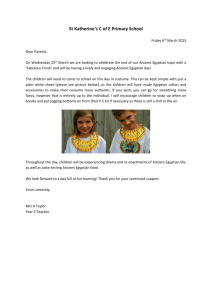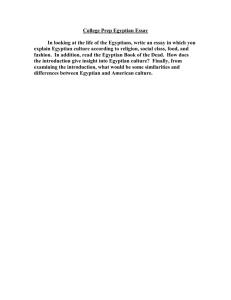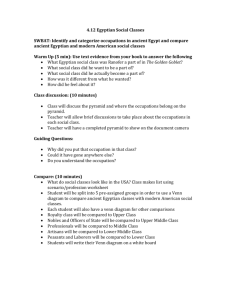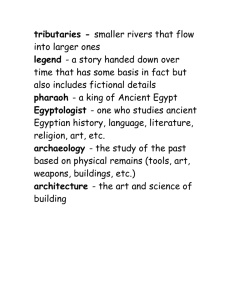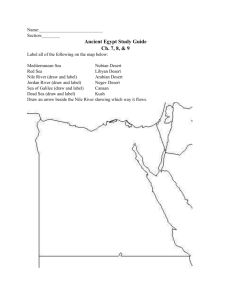Title: The Great Pyramid at Giza STEAM Lesson Brief Educators on
advertisement
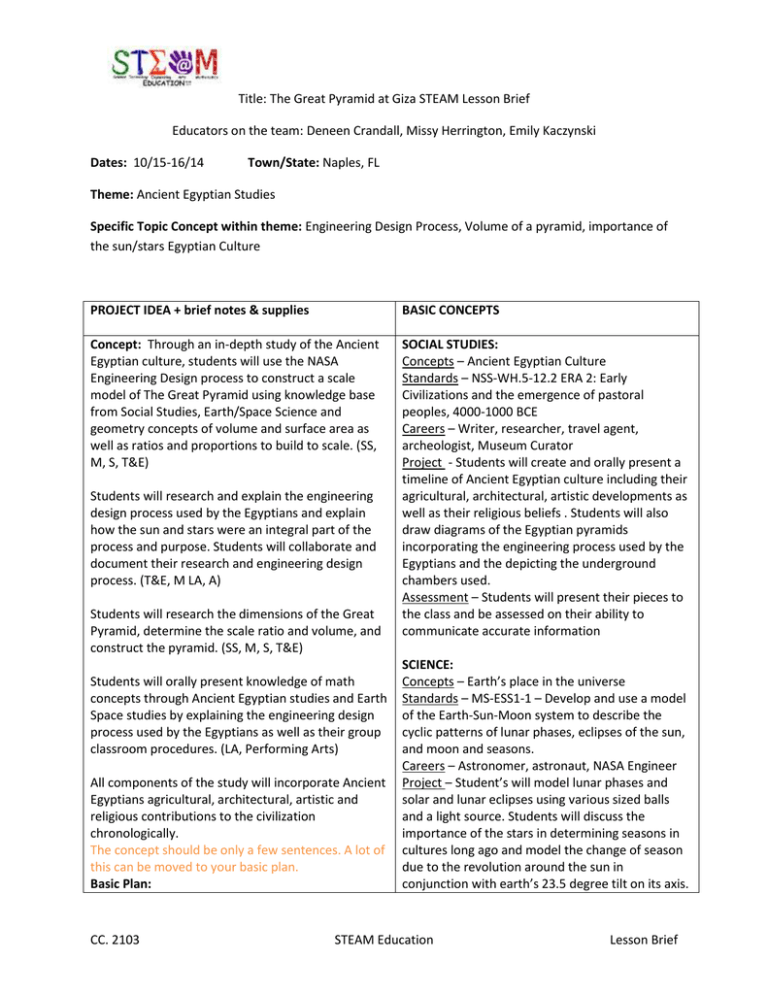
Title: The Great Pyramid at Giza STEAM Lesson Brief Educators on the team: Deneen Crandall, Missy Herrington, Emily Kaczynski Dates: 10/15-16/14 Town/State: Naples, FL Theme: Ancient Egyptian Studies Specific Topic Concept within theme: Engineering Design Process, Volume of a pyramid, importance of the sun/stars Egyptian Culture PROJECT IDEA + brief notes & supplies BASIC CONCEPTS Concept: Through an in-depth study of the Ancient Egyptian culture, students will use the NASA Engineering Design process to construct a scale model of The Great Pyramid using knowledge base from Social Studies, Earth/Space Science and geometry concepts of volume and surface area as well as ratios and proportions to build to scale. (SS, M, S, T&E) SOCIAL STUDIES: Concepts – Ancient Egyptian Culture Standards – NSS-WH.5-12.2 ERA 2: Early Civilizations and the emergence of pastoral peoples, 4000-1000 BCE Careers – Writer, researcher, travel agent, archeologist, Museum Curator Project - Students will create and orally present a timeline of Ancient Egyptian culture including their agricultural, architectural, artistic developments as well as their religious beliefs . Students will also draw diagrams of the Egyptian pyramids incorporating the engineering process used by the Egyptians and the depicting the underground chambers used. Assessment – Students will present their pieces to the class and be assessed on their ability to communicate accurate information Students will research and explain the engineering design process used by the Egyptians and explain how the sun and stars were an integral part of the process and purpose. Students will collaborate and document their research and engineering design process. (T&E, M LA, A) Students will research the dimensions of the Great Pyramid, determine the scale ratio and volume, and construct the pyramid. (SS, M, S, T&E) Students will orally present knowledge of math concepts through Ancient Egyptian studies and Earth Space studies by explaining the engineering design process used by the Egyptians as well as their group classroom procedures. (LA, Performing Arts) All components of the study will incorporate Ancient Egyptians agricultural, architectural, artistic and religious contributions to the civilization chronologically. The concept should be only a few sentences. A lot of this can be moved to your basic plan. Basic Plan: CC. 2103 SCIENCE: Concepts – Earth’s place in the universe Standards – MS-ESS1-1 – Develop and use a model of the Earth-Sun-Moon system to describe the cyclic patterns of lunar phases, eclipses of the sun, and moon and seasons. Careers – Astronomer, astronaut, NASA Engineer Project – Student’s will model lunar phases and solar and lunar eclipses using various sized balls and a light source. Students will discuss the importance of the stars in determining seasons in cultures long ago and model the change of season due to the revolution around the sun in conjunction with earth’s 23.5 degree tilt on its axis. STEAM Education Lesson Brief Students will complete an in-depth study of the Ancient Egyptian culture in Social Studies. In Science class, students will be introduced to NASA’s Engineering Design Process and be given the project criteria and constraints as well as job descriptions for their teams (scribe, engineer, builder.) In Math class, students will be taught how to find the volume of a square pyramid and practice calculations. Teams will implement the engineering design process in both math and science classes referring to research conducted in Social Studies class. In Art, students will create cartouches using hieroglyphics to represent their character, culture and family life. In Language Arts, student will read The Egypt Game by Zilpha Keatley Snyder and relate the story to their study of Ancient Egypt. In P.E., students will learn to play hockey, a sport played in Ancient Egyptian culture and compare and contrast the similarities and difference of the ancient sport and the sport as we know it today. In Music, students will be exposed to Egyptian music and instruments and compare and contrast other cultural music pieces and instrumentation. Skill level (Grade Range): Grade 6 Timing of Lesson: Math, Science, Social Studies, and Language arts - 6, 90 minute blocks Music, P.E.- 3, 45 minute classes Art – 4, 45 minute classes Basic Supplies: All Subjects: pencils, paper, laptops, iPad, positive work ethic Individual Subjects: Science – Various size balls, flashlights, colored pencils, paper, tacky glue, modeling blocks, toothpicks, cardboard, hot glue guns, rulers, box cutter (teacher use only,) graph paper, NASA Engineering Design process graphic organizer Do you have a link for this? Social Studies – chart strips, scissors Math – models of square pyramids, rulers PE – Indoor Hockey sticks, hockey puck/ball, cones, hockey goal Music – drums, tambourine, harp, finger chimes, world music selections CC. 2103 Students will also explore how the appearance of certain constellations in the sky informed Ancient Egyptians of the annual flooding of the Nile. Assessment – Students will take a written assessment drawing diagrams to demonstrate understanding of cyclic patterns of lunar phases, eclipses of the sun, and moon and seasons. TECHNOLOGY & ENGINEERING: Concepts – Implement NASA’s Engineering Design process Standards – Define a design problem that can be solved through development of an object, tool, process or system and includes multiple criteria and constraints, including scientific knowledge that may limit possible solutions. (MS-ETS1-1) Careers – Architect, Engineers, Programmers, Builder, Analyst, Mechanics Project - To construct a scale model of The Great Pyramid using knowledge base from Social Studies, Earth/Space Science and geometry math concepts of volume and surface area as well as ratios and proportions to build to scale implementing NASA’s Engineering Design process. What will they be using to build this model? Assessment – Student projects will be assessed according to the attached rubric Where is this rubric? MATH: Concepts – Determine volume of a pyramid using algebraic formula Standards – NCTM: Geometry: Use twodimensional representations of three-dimensional objects to visualize and solve problems such as those involving surface area and volume Careers – Architect, math teacher, Project – Students will find the volume of the Great Pyramid as well as their scale model using the formula for volume of a square pyramid Assessment – Students correctly compute the volume of the Great Pyramid and their scale model LANGUAGE ARTS: Concepts – Egyptian culture in literature; the writing process Standards – Uses new vocabulary that is introduced and taught directly (VS.LA.6.2.1) The student will STEAM Education Lesson Brief Art – sandpaper, paint, paper, pencils, scissors, paint brushes, paper towels, examples of Egyptian cartouches and hieroglyphics IT Resources: DiscoveryEducation.com Laptops/iPads Internet access for research Other Resources: Ask parents to provide boxes of modeling blocks found at Michael’s/Hobby Lobby (one/student) Photos: use background knowledge of subject and related content areas, pre-reading strategies, graphic representations, and knowledge of text structure to make and confirm complex predictions of content, purpose and organization of a reading selection. (VS.LA.6.3.1) The student will write expository essays that include a thesis statement, supporting details, and introductory and supporting paragraphs. (VS.LA.6.12.3) Careers – Writer, researcher, proof-reader Project – Compose a five paragraph essay on Egyptian innovation comparing the processes of building Step Pyramids, The Great Pyramid, and the Sphinx; Read The Egypt Game by Zilpha Keatley and discuss Egyptian rituals and culture integrated within the plot. Assessment – Students can convey to the reader using the writing process the similarities in the Egyptian building processes and students can determine cultural content within the reading selection ART: Concepts – Egyptian cartouches were ovals frames surrounding hieroglyphs that make up the name of an Egyptian God or royal person. A looped rope represents the magical power to protect the name that is written inside it. A cartouche was meant to protect against evil spirits both in this life and the afterlife. Standards - Connecting Anchor Standard 2: Relate artistic ideas and works with societal, cultural, and historical context to deepen understanding. Careers – Archeologist, Painter, Art Historian, Art History teacher Project – Students will design a cartouche of their own name and paint them on sandpaper. Students must use symbols that will represent their character, culture and family life. Assessment – Students can explain how the symbols in their cartouche represent themselves and how we might use Egyptian cartouches to learn about their culture. PE Concepts – Ancient Egyptians have been depicted playing hockey. Students will increase their knowledge regarding parts of the hockey stick, of CC. 2103 STEAM Education Lesson Brief basic rules and strategy in floor hockey, their ability to handle a puck while dribbling around an obstacle course and in game play. Students will increase their ability to pass and shoot as needed in a floor hockey game and activities. Standards – Standard 2 - The physically literate individual applies knowledge of concepts, principles, strategies and tactics related to movement and performance. Careers – Hockey player, sports sales, sports news reporter, referee, sporting equipment designer, sporting goods sales and marketing Project – Student will play floor hockey applying skills learned Assessment – Students will take the pass test by passing with a partner to acquire a score. Students will dribble through a set of cones to acquire a timed score. Students will shoot at a goal to acquire a score. MUSIC Concepts – Develop understanding of cultural differences in music selection and techniques Standards – MU.68.C.1.1: Develop strategies for listening to unfamiliar music works. Careers – Composer, conductor, Project – Students will listen to music from various cultures to determine differences in instrumentation, meter and emotion. Students will listen and play instruments such as harps, lyres, lutes, drums, rattles, tambourines, and bells discussing their use in Egyptian culture. Students will compose rhythm patterns heard in Egyptian music selections. Cognition and reflection are required to appreciate, interpret and create with artistic intent. Assessment – Students must correctly identify music from the Egyptian culture from other cultural pieces naming instruments used in the Egyptian selection. CC. 2103 STEAM Education Lesson Brief Links: www.dl.ket.org/humanities/connections/class/ancient/coffin.htm www.otagomuseum.govt.nz/assets/Files/mummy.pdf www.aldokkan.com/art/sarcophagus.htm Ancient Egyptian Musicwww.youtube.com/watch?v=vGaRZbaosOs Egyptian Musicwww.youtube.com/watch?v=vslsS-Uu5x4 Egyptian Music - Traditional Arabic Music www.traditionalarabicmusic.com/music_of_egypt.html 2Hours of Traditional Chinese Music www.youtube.com/watch?v=K7CseTNRZ_0 Traditional Latin Music www.youtube.com/watch?v=w3Zu3foSc7A Roots of Blues www.youtube.com/watch?v=tvsbFc8uzOY African Music Rhythm www.youtube.com/watch?v=qEwnHf9Q23k Hieroglyphic Numerals https://www.easycalculation.com/funny/numerals/egyptian.php The Great Pyramid CC. 2103 STEAM Education Lesson Brief http://www.britannica.com/EBchecked/topic/234470/Pyramids-of-Giza CC. 2103 STEAM Education Lesson Brief


